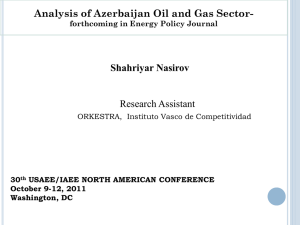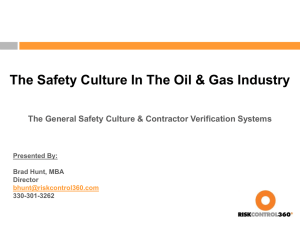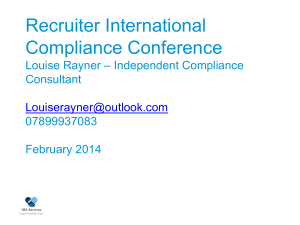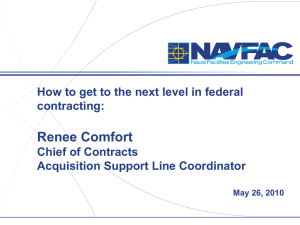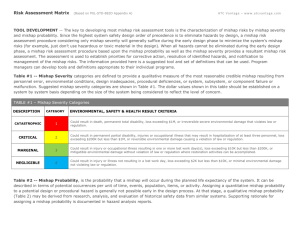NAVFAC PAC BOD - National Contract Management Association
advertisement
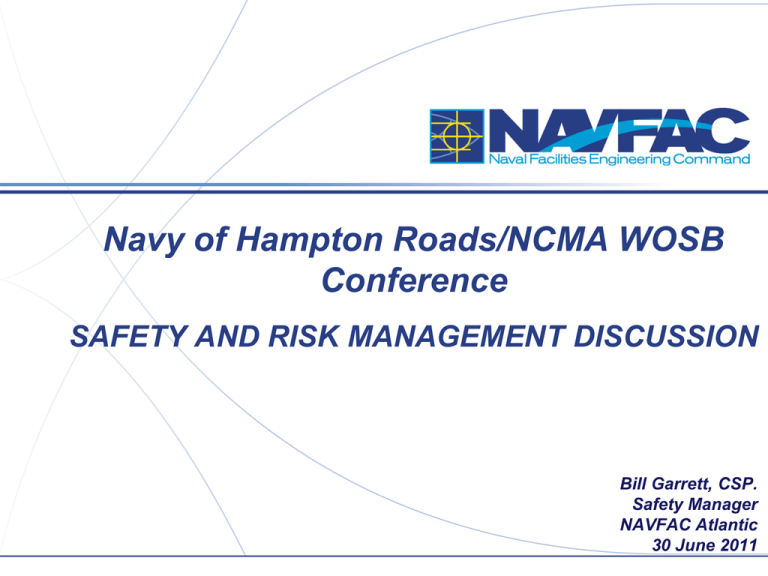
Navy of Hampton Roads/NCMA WOSB Conference SAFETY AND RISK MANAGEMENT DISCUSSION Bill Garrett, CSP. Safety Manager NAVFAC Atlantic 30 June 2011 NAVFAC Safety Program Selection Factor Minimum Standards Strengthened Partnerships Bureau of Labor Statistics National Construction Industry DART Rate 2 2 Contractor Fatality Crushed by Dump Truck Fresh asphalt Paving machine • Activity: A worker was bent over laying out a string line to be used as a paving guide in the front blind spot of a dump truck. The dump truck spotter walked from the front of the truck to the rear tapping the worker on the hard hat cautioning him of the impending truck movement. Spotter then made eye contract with the driver through the passenger side window signaling to back the dump truck up to the paving machine. Driver unaware of the crouching worker in the front blind spot traveled forward instead of backward in order to reposition the truck so the front tires wouldn’t roll through the adjacent fresh asphalt. As the truck rolled forward the worker was crushed and killed by the right front tire. • Direct cause: Working in close proximity to heavy equipment Driver unable to see - blind spot directly in front Spotter location at time of incident Victim impact 3 • Indirect cause: Spotter had his back turned to the vehicle after signaling to the driver Noise from wind, dump truck, and airfield • Lessons learned: Laborers, drivers and spotters need to be fully cognizant of moving vehicles and blind spots Spotters need to maintain positive control of vehicle movements at all times 3 Employee crushed during backing operation of a 15 passenger van Stop backward travel when contact with the spotter is lost. Manage onsite material storage to ensure access routes, parking, and storage areas do not conflict Establish and Communicate plans to all employees. Site layout plans and traffic control plans - required in the APP. Encourage employees to immediately report changed site conditions. • Direct cause: Poor spotter/operator communication Lost sight of spotter - should not have continued to back up without 100% positive verification from the ground guide that it was safe to continue. Over react ion - startled operator • Indirect cause: Two foot driving (brake/accelerator simultaneously) • Lessons learned: No written or enforced site layout required by EM 385-1-1 Section 04.A.01. 4 4 Crushed by a Front End Loader (FEL) Direct Cause: Mixed pedestrian traffic and heavy equipment operation in the same area of the site Operator did not see the victim in front of him & victim did not see FEL coming down the hill No spotter (ground guide) was provided to direct traffic Prime and subcontractors did not read each others AHAs 5 5 Contract Preparation Contractor Selection Contract Award Mutual Understanding Evaluate the Work Safety integration in the Navy Contracting Process (Six Steps) Post-Contract Evaluation 6 6 Safety – Step 1 Contract Preparation Contractor Selection Contract Award Mutual Understanding Evaluate the Work Key Elements (NAVFAC) • Develop contract documents that tailors language to clarify safety expectations specific to particular contract. • Communicate expectations for enforcing the contract safety program management requirements – establish lines of authority. Documents: • USACE EM 385-1-1. • Standardized Safety Specification • OSHA 29 CFR 1926/1910. Desired Outcome • Bid documents and RFP’s that effectively communicate safety expectations Post-Contract Evaluation 7 7 Safety – Step 2 Contract Preparation Contractor Selection Contract Award Mutual Understanding Evaluate the Work Post-Contract Evaluation 8 Participants • Acquisition, Project Managers, Safety Advisor • Insurance companies • OSHA • Source Selection Board (90% of all contracts) Key Elements • Safety performance evaluation (stand alone). • NAVFAC wants contractors who are compatible with Navy/owner operating safety principles. • Subjective evaluation of performance data: EMR’s, injury rates, recognition, program narrative, innovation, and overall competency. Desired Outcome • Qualified bidders with proven safety performance track record. • Proper start-up of the contracting process. • Strong safety influences quality (relationship). 8 Safety – Step 3 Contract Preparation Contractor Selection Contract Award Mutual Understanding Key Elements • Conduct a thorough review of contract safety specifications at bid & pre-award meetings. • Develop key personnel (contractors incorporate in sub-contract agreements). • Identify contractually the minimum qualifications of supervisors at each work site for safety auditing who meet minimum training requirements (corporate policy or as specified in contract documents). NAVFAC Examples:OSHA 30 Hour Certification; and web based training. Evaluating the Work Post-Contract Evaluation 9 Desired Outcome • Clear, common understanding of safety expectations by all parties 9 Safety – Step 4 Contract Preparation Contractor Selection Contract Award Mutual Understanding Evaluating the Work Post-Contract Evaluation 10 Key Elements • Orientation: Assure all employees embrace your “safety culture” delivered through effective initial orientations (assure language). • Develop a Site Specific Accident Prevention Plan (APP). • Conduct a contract pre-work management safety conference (Pre-con): Get the right people (owner and contractor) to participate. • Identify designated site safety managers (SSMs) and assure minimum qualifications (OSHA 30 Hour). Desired Outcome • Knowledge, understanding, and commitment to safety requirements by workforce. • Expect some worker self elimination. • Create accountability on site. 10 Safety – Step 5 Contract Preparation Contractor Selection Contract Award Mutual Understanding Evaluating the Work Post-Contract Evaluation 11 Key Elements • Create an environment where routine audits are directed at injury prevention rather than “policing”. • Incorporate as part of payment process. • Develop an audit that results in a rating. • Establish a deficiency tracking system with corrective actions. • Assure Pre-task/planning safety control tool Activity Hazard Analysis process. • Focus on “High Risk” activities. • Establish a mishap notification system which includes the full chain of management. • Engage company principals if mishaps occur. • Review each mishap (including near miss). Establish a mishap review board (MRB) address accountability. • Share/communicate mishap lessons learned. 11 Safety – Step 6 Contract Preparation Contractor Selection Contract Award Mutual Understanding Evaluating the Work Post-Contract Evaluation 12 Key Elements • Mandatory mid and end of contract and employee evaluations: process identifying poor and rewarding superior performance. • Safety “STAR” incentive program - safety through awards & recognition. • Evaluate corporate mishap metrics to benchmark with industry and identify trends to assist in continuous improvement and prevention. • Include safety performance in employee incentives and disincentives at all levels. Desired Outcome • Contractor improves future performance • NAVFAC improves contracting process • No negative impact on war fighter readiness 12 Understanding safety in the source selection process • Consistent process to assure NAVFAC is contracting with partners that have proven safety positive performance and proactive sub contractor management practices. • Improved project quality • Stewardship of public funds and interest • Reduced execution oversight effort by field personnel • Goal – encourage/influence safety by rewarding good performance. • Client feedback - Limit disruption impacts to operations. Development team led by AQ collaborated with industry 13 13 Source Selection - Consistency 1) Safety – stand alone factor in selecting contractors. 2) Elements (collectively considered): (a) Experience Modification Rate (EMR), (b) Days Away, Restricted Duty, or Transfer (DART) rate, (c) Technical approach to safety - two page narrative - focus on sub contractor management and selection practices 3) Start date 1 January 2011 – All Contracts. 4) SSM serves as TEB “advisor”. 5) Look at trends. 14 14 Evaluation Criteria – EMR/DART (1) Experience Modification Rate (EMR): • The Government will evaluate the EMR to determine if the Offeror has demonstrated a history of safe work practices taking into account any upward or downward trends and extenuating circumstances that impact the rating. Lower EMRs will be given greater weight in the evaluation. (2) OSHA Days Away from Work, Restricted Duty, or Job Transfer (DART) Rate: • The Government will evaluate the OSHA DART Rate to determine if the Offeror has demonstrated a history of safe work practices taking into account any upward or downward trends and extenuating circumstances that impact the rates. Lower OSHA DART Rates will be given greater weight in the evaluation. 15 15 (3) Two Page Narrative The Government will evaluate the narrative to determine the degree to which safety performance will be considered in the selection of all subcontractors. The Government will also evaluate the narrative to determine the degree to which innovations are being proposed that may enhance safety on the procurement. Those Offerors whose plan demonstrates a commitment to hire subcontractors with a culture of safety and who propose innovative methods to enhance a safe working environment may be given greater weight in the evaluation. 16 16 Basis of Evaluation: The Government is seeking to determine if the Offeror has consistently demonstrated a commitment to safety and plans to properly manage and implement safety procedures for itself and subcontractors. The Government will evaluate the overall safety record. While the Government may elect to consider data from other sources, the burden of providing detailed, current, accurate and complete information regarding submittal requirements rests with the Offeror. 17 17



